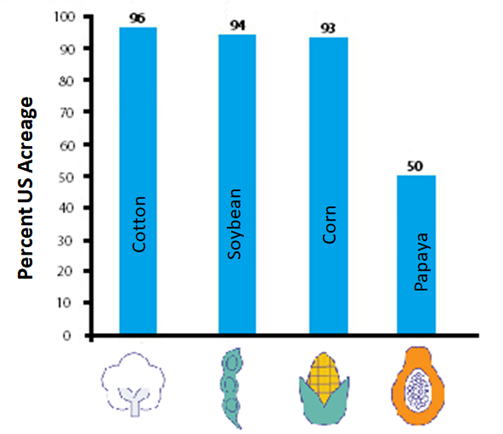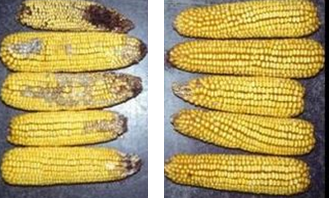Genetically Modified Crops
Can you guess
the above 2 fruits? The above 2 are the same! Shocked! Yes, they both are
Watermelon. But one is naturally
occurring and the other one is made by the interference of humans, with a
simple technique called cross breeding or selective breeding. The same has been
done for a lot of crops like Banana, Eggplant, Carrots, etc.
Techniques like
cross breeding and selective breeding are very traditional and humans have been
using them to modify their crops. This has helped them in growing better crops,
be it in terms of growth, taste or traits. But these method is more of a hit
and trial and can take a lot of time.
But the modern
world which is full of technology and development offers us a new and better
technique known as Agriculture Bio-Technology. Biotechnology is the use of an
organism, or a component of an organism or other biological system, to make a
product or process for a specific use. Agriculture Bio-Technology or AgriTech
is a technique involving use of various scientific technique to change the gene
or DNA of a plant to get a desired and profitable agricultural crop. The
desired trait are taken from other organism and passed on to other one which
lacks it. These desired crops have improved qualities in terms of color,
flavor, growth rate, size of harvested crops and resistance to pests and
diseases. The crops which uses the agriculture biotechnology are known as Genetically Modified Crops or simply GM
Crops.
Fig: Currently grown GM crops in the
U.S
Why
we need GM crops?
Although growing
a better crop was always on humans mind but with the growing population it has
become a necessity. Our current
agriculture industry faces a lot of other problems too like crops are prone to
a lot of pests, weeds and diseases. All this results in poor crop quality.
Agricultural bio-Technology is one of our best shot in addressing the problem
of increase population and many more.
How GM crops are made?
To understand
the making of GM crops let’s take an example of BT corn. Usually plants are
prone to insects and pests and that is why insecticide and pesticides are used.
The corn which was grown by farmers was also prone to a pest known as Corn
Borer. Because of this their crops reduces in quantity as well as quality.
Using pesticide means not only killing the harmful insects but the useful ones
too. Also while spraying pesticides farmers has to be continuously be in the
toxic environment too that can lead to their bad health. How this problem can
be addressed? The GM crops are the best answer to it. Let’s understand how it
works!
a.
DETECT: To produce a GM plant,
scientists first find what characteristic they want that plant to have, such as
resistance to pests or insects. Then, they search for an organism (plant,
animal, or microorganism) that already has that trait encoded within its DNA.
In our example, scientists wanted to create pest-resistant corn to reduce the
need to spray pesticides. They detected a gene in Bacillus thuringiensis (Bt, a
soil bacterium), which produces a natural pesticide that is known for many
years in our old agriculture practices.
b.
TRANSCRIPT: Once the desired
trait is identified and the organism containing that trait, the desired genes
are transcribed. To put it simply the DNA or the desired gene is copied. In our
example the gene from Bt is copied which is pest resistant.
c.
TRANSFER: The transcribed DNA
is then transfer to our desired plant using scientific tools and techniques. By
inserting the Bt gene into the DNA of the corn plant, scientists gave it the
insect resistance trait.
d.
GROW: At this stage, scientists
grow the new plant in labs to make sure the gene which has been transferred to
the plants works the way it has been designed. Also the new plant should adopt
all the external and internal conditions of the plant. Then the new plants are
transferred to the field.
So
the new Bt corn has the ability to resist the corn borer and farmers can get a
better quality crop.
Fig: Normal corn V/S Bt Corn
Pros and Cons of GM Crops
Although
Selective breeding is a more natural way to get desired traits but that is also
a lengthy and time taking process. GM Crops have the modification which
accelerates the process and giving the required traits quickly as compared to
our traditional ways.But unlike any other thing everything has some good and
bad effects.
Pros
As we can
observe in our example how the Bt Corn was resistant to pests. Similarly other
modification can make a crop survive severe conditions like droughts or floods,
resist to insects and pests and diseases, give farmers higher yields, can alter
the size, color or flavor of crops as per the requirement. All these things
together helps the farmers not only in having good quality crops but also
reducing the overall cost.
Other than this
GM crops can be modified to get better nutritional values in our food. For
example Golden Rice was developed which has high Vitamin A values. Lack of
Vitamin A in one’s diet can lead to blindness. So the Golden Rice is grown to
help prevent blindness in areas where local diet lacks Vitamin A chronically.
Cons
Although GM
Crops offers a wide range of benefits to us and our environment, but not knowing
enough about them can turn the things in opposite direction. Their benefits has
given them a positive lime light but there are also concerns about their long
term safety and impact on environment.
The first most
concern regarding GM Crops is that they may trigger allergic reaction. Since
the genes introduced to the plants are foreign gene, they can cause reactions
in humans which were previously unknown. Although the GM Crops are under the
FDA and they go through a lot of testing but there are still so many things
which can go uncheck.
Similarly,
there’s a common concern that GM foods may aid the advance of cancers. Because
cancers are caused by DNA mutations, some people fear that eating foods with mutated
genes in the GM Food might affect ones DNA.
The Future
The future of GM
Crops or Agricultural Bio-Technology is very promising as it will improve our
efforts to meet the global needs for food. Using agricultural Bio-Technology we
can grow crops that can give us high yield in lesser land solving our one more
problem of deforestation. Also we can create plants that will have the genes to
absorb more harmful gases like CO2 and N2 which are
leading causes of Global Warming. Agricultural Bio-Technology can be tool for
us to reverse the harmful changes we have made to the environment.
But while
creating all the mutation we should always keep in mind that mutations can
cause changes which can remain with the plant for forever. So every possible
test should be done while making these crops or plants. Rigorous research, Lab
Tests should be done. Collected data should be stored and analyzed from time to
time to avoid any major impacts on our environment. As we all have heard
“Precaution is better than Cure”, keeping this in mind we should carry forward
with Agricultural Bio-Technology. And soon this Technology will become our
Savior.
Author
Uma @ Team Agrix




